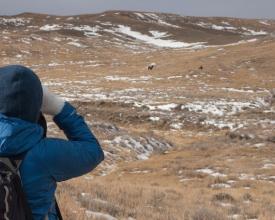Collecting Wildlife Data through Volunteer Citizen Scientists
Snapshot Solution

A Landmark volunteer looks out across the prairie, taking a brief break from collecting wildlife data. © American Prairie Reserve
American Prairie Reserve embarked on a multi-year journey with Adventurers and Scientists for Conservation (ASC) through Landmark, a citizen science program. Landmark aims to collect key wildlife data, building a global constituency for this ecosystem, and recording human experience living on the prairie. ASC directs Landmark, recruiting and training volunteer crew to live on the Reserve for two-month periods and collect data year round using tablet technology.
Last update: 02 Oct 2020
2401 Views
Context
Challenges addressed
Location
American Prairie Reserve Hq, Malta, MT, United States
North America
Impacts
ASC collects data year round, exploring the grasslands from the subzero weather of January to the heat of July and August. The collected data is stored in an open-source database, used to manage and protect this wild landscape. Using GPS points and camera trap images, the data intends to establish wildlife trends over time and inform management decisions as the Reserve grows, with particular focus on wildlife-fence interactions, wildlife density estimates, prairie dog town mapping, bison calf counts, and big cat movements. Through Landmark, we are harnessing the power of this intrepid and naturally curious group to help us achieve wildlife, human history, and land management goals.
